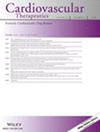厚朴酚通过PI3K/AKT信号通路抑制线粒体凋亡,对心肌缺血/再灌注损伤(MI/RI)提供心脏保护
IF 3.4
4区 医学
Q2 CARDIAC & CARDIOVASCULAR SYSTEMS
引用次数: 3
摘要
背景心肌损伤是心肌缺血/再灌注损伤(MI/RI)的主要并发症。厚朴酚是从传统中草药厚朴中提取的一种公认的活性化合物,用于治疗不同的血管疾病。本研究旨在探讨本木酚是否可以减轻心肌梗死/心肌缺血再灌注模型的心肌损伤。方法雄性C57BL/6小鼠78只,随机分为假手术组(Sham)、MI/RI组(Con)和Honokiol组(每组26只)。Honokiol组小鼠在MI/RI手术前接受Honokiol治疗(0.2 mg/kg/天,连续14天,腹腔注射),而Con组小鼠在MI/RI暴露前14天每天腹腔注射等量的载体(DMSO)。术后测定肌酸激酶- (CK-) MB、心肌肌钙蛋白T (cTnT)水平及梗死面积,评估心肌损伤程度。采用末端脱氧核苷酸转移酶dUTP镍端标记(TUNEL)染色检测细胞凋亡水平。电镜观察线粒体损伤。最后,利用western blotting分析甘油醛-3-磷酸脱氢酶(GAPDH)、cleaved caspase-9、细胞色素C (Cyt-C)、B细胞淋巴瘤/白血病-2 (Bcl-2)、B细胞淋巴瘤/白血病-2相关X (Bax)、AKT、p-AKT、PI3K和p-PI3K的表达水平。结果厚木酚可通过激活PI3K/AKT信号通路,降低心肌细胞cTnT和CK-MB水平、细胞凋亡指数和线粒体肿胀。结论厚朴酚通过PI3K/AKT信号通路抑制线粒体凋亡,对心肌梗死/心肌梗死具有保护作用。本文章由计算机程序翻译,如有差异,请以英文原文为准。
Honokiol Provides Cardioprotection from Myocardial Ischemia/Reperfusion Injury (MI/RI) by Inhibiting Mitochondrial Apoptosis via the PI3K/AKT Signaling Pathway
Background Myocardial injury refers to a major complication that occurs in myocardial ischemia/reperfusion injury (MI/RI). Honokiol is a well-recognized active compound extracted from the traditional Chinese herb known as Magnolia officinalis and is utilized in treating different vascular diseases. This research is aimed at examining whether Honokiol might alleviate myocardial injury in an MI/RI model. Methods Seventy-eight male C57BL/6 mice were categorized randomly into three cohorts including the Sham operation (Sham) cohort, the MI/RI cohort (Con), and the Honokiol cohort (n = 26 for each cohort). The mice in the Honokiol cohort were treated with Honokiol before MI/RI surgery (0.2 mg/kg/day for 14 days, intraperitoneal), while the mice in the Con cohort were given an intraperitoneal injection with an equivalent volume of vehicle (DMSO) daily in 14 days prior to exposure to MI/RI. After the surgery, creatine kinase- (CK-) MB and cardiac troponin T (cTnT) levels, as well as the infarct area, were measured to assess the degree of myocardial damage. Apoptotic levels were detected using terminal deoxynucleotidyl transferase dUTP nick-end labeling (TUNEL) staining. Electron microscopy was utilized to identify mitochondrial damage. Lastly, the expression levels of glyceraldehyde-3-phosphate dehydrogenase (GAPDH), cleaved caspase-9, cytochrome C (Cyt-C), B cell lymphoma/leukemia-2 (Bcl-2), B cell lymphoma/leukemia-2 associated X (Bax), AKT, p-AKT, PI3K, and p-PI3K were analyzed utilizing western blotting. Results Honokiol can reduce the MI/RI-induced cTnT and CK-MB levels, apoptosis index, and mitochondrial swelling in cardiomyocytes via activating the PI3K/AKT signaling pathway. Conclusion Honokiol provides cardiac protection from MI/RI by suppressing mitochondrial apoptosis through the PI3K/AKT signaling pathway.
求助全文
通过发布文献求助,成功后即可免费获取论文全文。
去求助
来源期刊

Cardiovascular Therapeutics
医学-心血管系统
CiteScore
5.60
自引率
0.00%
发文量
55
审稿时长
6 months
期刊介绍:
Cardiovascular Therapeutics (formerly Cardiovascular Drug Reviews) is a peer-reviewed, Open Access journal that publishes original research and review articles focusing on cardiovascular and clinical pharmacology, as well as clinical trials of new cardiovascular therapies. Articles on translational research, pharmacogenomics and personalized medicine, device, gene and cell therapies, and pharmacoepidemiology are also encouraged.
Subject areas include (but are by no means limited to):
Acute coronary syndrome
Arrhythmias
Atherosclerosis
Basic cardiac electrophysiology
Cardiac catheterization
Cardiac remodeling
Coagulation and thrombosis
Diabetic cardiovascular disease
Heart failure (systolic HF, HFrEF, diastolic HF, HFpEF)
Hyperlipidemia
Hypertension
Ischemic heart disease
Vascular biology
Ventricular assist devices
Molecular cardio-biology
Myocardial regeneration
Lipoprotein metabolism
Radial artery access
Percutaneous coronary intervention
Transcatheter aortic and mitral valve replacement.
 求助内容:
求助内容: 应助结果提醒方式:
应助结果提醒方式:


